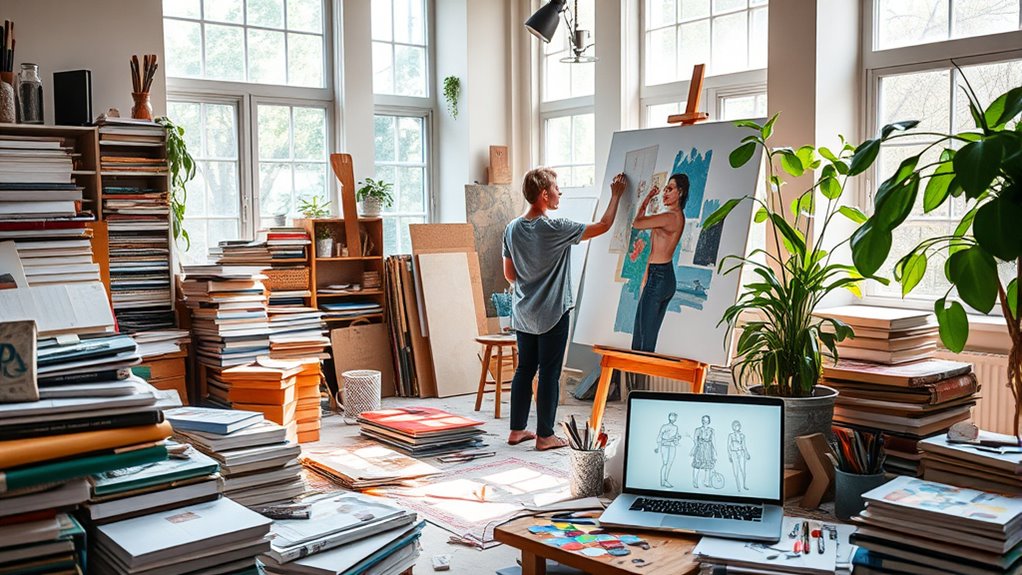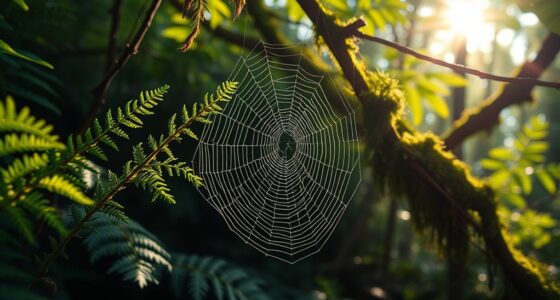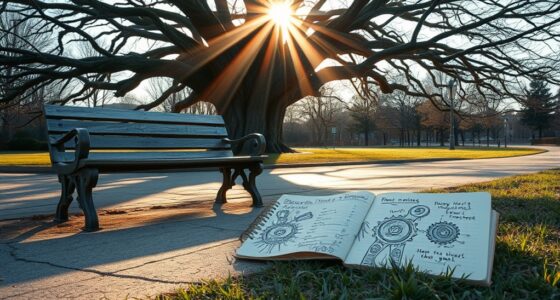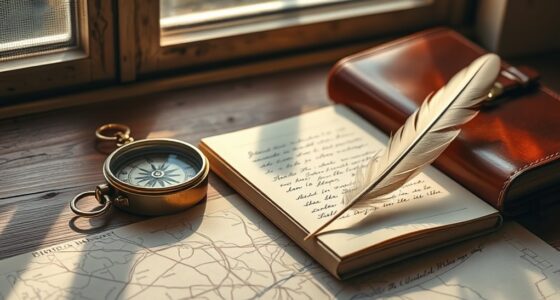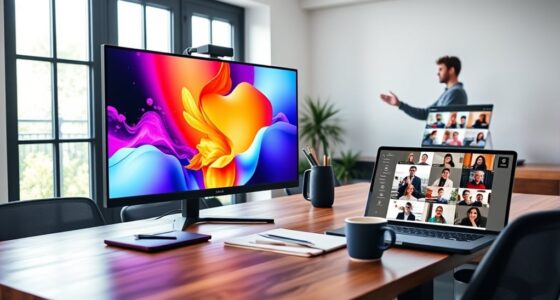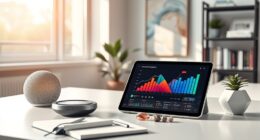To find flow and sustain creativity, start by creating a focused environment free of distractions, like silencing notifications and organizing your space. Practice mindfulness techniques such as breathing exercises or body scans to clear your mind before starting tasks. Develop a routine to help you enter flow easily and build mental discipline over time. When you combine these strategies with intentional workspace adjustments, you’ll unleash deeper focus—keep exploring to discover even more ways to master your creative flow.
Key Takeaways
- Practice mindfulness exercises like focused breathing and body scans to train your attention and reduce distractions.
- Create a dedicated, clutter-free workspace with optimal lighting and noise control to promote focus.
- Establish consistent routines that signal your brain it’s time to enter a focused, flow state.
- Use environmental cues, such as calming elements, to trigger and support sustained concentration.
- Combine mental training and environment adjustments regularly to develop and maintain effortless, creative flow.

Have you ever experienced that effortless focus where time seems to disappear? That state of complete immersion, often called flow, is what many creatives chase. Achieving it isn’t about waiting for inspiration to strike; it’s about actively cultivating the conditions that foster deep concentration. One effective way to do this is through mindfulness exercises. By practicing mindfulness, you train your mind to stay present, reducing distractions and mental clutter. Simple techniques like focused breathing or body scans help center your attention, making it easier to slip into a flow state. These exercises heighten your awareness of your thoughts and surroundings, allowing you to recognize when your mind drifts and gently bring it back. Over time, this mental discipline becomes a dependable tool to enter flow more quickly and sustain it longer.
Alongside mindfulness exercises, environmental adjustments profoundly influence your ability to find flow. Your surroundings play a vital role in shaping your focus and energy levels. Start by creating a workspace that minimizes distractions—turn off notifications, tidy up clutter, and set specific boundaries to signal that you’re in a focused mode. Consider lighting, noise, and ergonomics as well. Bright, natural light energizes you, while noise-canceling headphones can block out disruptive sounds. If your environment tends to pull your attention away, experiment with different settings until you find a space that feels conducive to sustained concentration. Sometimes, simply rearranging your workspace or adding calming elements like plants or artwork can make a big difference. The goal is to craft an environment that cues your brain to shift into a productive, focused state. Incorporating powerful persuasive words into your environment or routines can also boost motivation and engagement, making it easier to enter and maintain flow.
Integrating mindfulness exercises into your routine and adjusting your environment go hand in hand. Before diving into a task, take a few moments for mindful breathing or a quick body scan to clear your mind. Then, guarantee your surroundings support your focus—eliminate potential interruptions, optimize lighting, and personalize your space to inspire creativity. These small, intentional changes compound over time, making it easier to slip into flow and stay there longer. When your mind is trained to stay present and your environment is aligned with your goals, you create a fertile ground for sustained creativity. Remember, flow isn’t a mysterious phenomenon; it’s a skill you develop through deliberate practice and thoughtful setup. With consistency, you’ll find it becomes easier to access and maintain that seamless state of focused productivity.
Frequently Asked Questions
How Does Flow Differ Across Various Creative Disciplines?
Flow varies across disciplines because each field involves different challenges and skills. In interdisciplinary approaches, you blend techniques from multiple areas, which can enhance your flow experience. Cultural influences shape how you perceive and achieve flow, making it unique for every individual. You might find it easier to enter flow in visual arts, while in music, emotional expression plays a bigger role. Adapting your approach to your discipline and culture helps sustain creativity.
Can Flow Be Achieved in Short-Term or Sporadic Tasks?
Think of flow as a fleeting butterfly—you can catch it even in short bursts. Yes, you can achieve flow in short-term or sporadic tasks by embracing temporary focus and breaking your work into smaller segments. Task segmentation helps you dive deep into each part, making it easier to stay engaged. With mindful effort, you can summon that creative energy even during brief moments, turning fleeting focus into a productive dance.
What Role Does Environment Play in Maintaining Flow?
Your environment plays a vital role in maintaining flow. You should optimize ambient lighting to reduce eye strain and create a calming atmosphere. Keep your workspace organized to minimize distractions and help you stay focused on your task. When your surroundings are comfortable and clutter-free, you find it easier to enter and sustain a flow state, boosting your creativity and productivity throughout your work session.
Are There Specific Personality Traits Linked to Easier Flow Experiences?
You might think personality traits determine your ability to experience flow, but creative predispositions also play a role. People with traits like openness, resilience, and intrinsic motivation often find it easier to stay absorbed in tasks. While traits influence your likelihood, they’re not fixed. You can develop habits and environments that foster flow, regardless of your personality, making sustained creativity accessible to everyone willing to cultivate these qualities.
How Can Technology Both Help and Hinder Sustained Creativity?
Technology can boost your creativity with powerful digital tools that streamline ideas and inspire innovation. However, digital distractions often pull you away from focused work and disrupt your flow. To stay creative, set boundaries around your screen time and choose effective creative tools that enhance your process. By managing distractions and leveraging the right technology, you can sustain your creativity and maintain a productive flow state.
Conclusion
Now that you’ve explored these techniques, are you ready to embrace your creative flow fully? Remember, sustained creativity isn’t about waiting for inspiration; it’s about actively cultivating the mindset and environment that allow your ideas to flourish. Every moment you dedicate to finding your flow brings you closer to unleashing your full potential. So, what’s stopping you from making creativity a natural part of your daily life? The world’s waiting for your unique brilliance.
